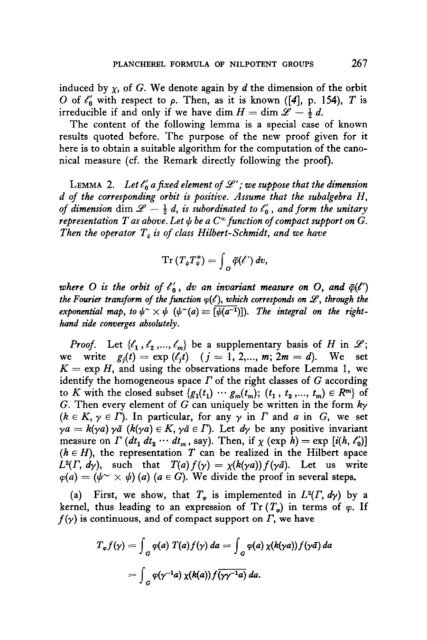On the Characters and the Plancherel Formula of Nilpotent Groups ...
On the Characters and the Plancherel Formula of Nilpotent Groups ...
On the Characters and the Plancherel Formula of Nilpotent Groups ...
You also want an ePaper? Increase the reach of your titles
YUMPU automatically turns print PDFs into web optimized ePapers that Google loves.
PLANCHEREL FORMULA OF NILPOTENT GROUPS 267<br />
induced by x, <strong>of</strong> G. We denote again by d <strong>the</strong> dimension <strong>of</strong> <strong>the</strong> orbit<br />
0 <strong>of</strong> 8; with respect to p. Then, as it is known ([4], p. 154), T is<br />
irreducible if <strong>and</strong> only if we have dim H = dim $P - + d.<br />
The content <strong>of</strong> <strong>the</strong> following lemma is a special case <strong>of</strong> known<br />
results quoted before. The purpose <strong>of</strong> <strong>the</strong> new pro<strong>of</strong> given for it<br />
here is to obtain a suitable algorithm for <strong>the</strong> computation <strong>of</strong> <strong>the</strong> cano-<br />
nical measure (cf. <strong>the</strong> Remark directly following <strong>the</strong> pro<strong>of</strong>).<br />
LEMMA 2. Let 8; a$xed element <strong>of</strong> 3”; we suppose that <strong>the</strong> dimension<br />
d <strong>of</strong> <strong>the</strong> corresponding orbit is positive. Assume that <strong>the</strong> subalgebra H,<br />
<strong>of</strong> dimension dim 9 - 4j d, is subordinated to & , <strong>and</strong> form <strong>the</strong> unitary<br />
representation T as above. Let z,h be a C” function <strong>of</strong> compact support on G.<br />
Then <strong>the</strong> operator T$ is <strong>of</strong> class Hilbert-Schmidt, <strong>and</strong> we have<br />
where 0 is <strong>the</strong> orbit <strong>of</strong> t$ , dv an invariant measure on 0, <strong>and</strong> $(el)<br />
<strong>the</strong> Fourier transform <strong>of</strong> <strong>the</strong> function v,(l)>, which corresponds on 9, through <strong>the</strong><br />
exponential map, to #” x $ (#“(a) = [#(a-‘)]). The integral on <strong>the</strong> right-<br />
h<strong>and</strong> side converges absolutely.<br />
Pro<strong>of</strong>. Let {8r , 4, ,..., 4,) be a supplementary basis <strong>of</strong> H in 3’;<br />
we write gj(t) = exp (t’&) (j = 1, 2,..., m; 2m = d). We set<br />
K = exp H, <strong>and</strong> using <strong>the</strong> observations made before Lemma 1, we<br />
identify <strong>the</strong> homogeneous space I’ <strong>of</strong> <strong>the</strong> right classes <strong>of</strong> G according<br />
to K with <strong>the</strong> closed subset {gl(tl) *a. gm(t,); (tI , t, ,..., tJ E Rm} <strong>of</strong><br />
G. Then every element <strong>of</strong> G can uniquely be written in <strong>the</strong> form kr<br />
(K E K, y E r). In particular, for any y in r <strong>and</strong> a in G, we set<br />
ya = k(ya) yd (k(ra) E K, yd E r). Let dy be any positive invariant<br />
measure on r (dt, dt, *** dt,, say). Then, if x (exp h) = exp [i(h, &)I<br />
(h E H), <strong>the</strong> representation T can be realized in <strong>the</strong> Hilbert space<br />
L2(r, dr), such that T(a) f (y) = x(k(ya)) f (yd). Let us write<br />
v(a) = (#- x #) (a) (a E G). We divide <strong>the</strong> pro<strong>of</strong> in several steps.<br />
(a) First, we show, that T, is implemented in L2(P, dr) by a<br />
kernel, thus leading to an expression <strong>of</strong> Tr (T,) in terms <strong>of</strong> CJJ. If<br />
f(y) is continuous, <strong>and</strong> <strong>of</strong> compact support on r, we have

















